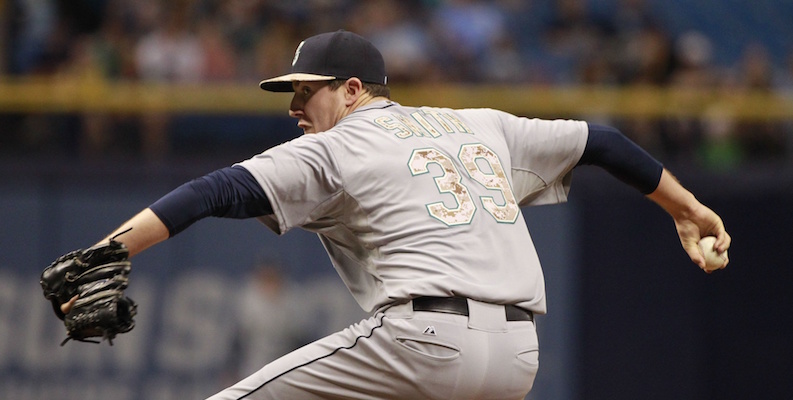On November 12, the Red Sox had a bad bullpen. Koji Uehara and Junichi Tazawa were still at the head, but both were relative question marks coming off down seasons. On November 13, the Red Sox traded for Craig Kimbrel, and all of a sudden they had a good bullpen. That’s what bringing in one of the best relievers of all time will do.
On December 7, the Red Sox traded for Carson Smith (and Roenis Elias), and all of a sudden they had a great bullpen. That’s what bringing in one of the best young relievers in the game will do.
This is sort of an oversimplification of how Boston’s offseason has gone, but it’s also an accurate rough sketch. The Red Sox bullpen went from bad to good to great in two moves, using a get-rich-quick scheme that may actually work.
We all know who Kimbrel is, to the point where it’s not really worth discussing him much. (Actually, that’s not accurate — he’s always worth discussing.) With that said, he’s not really as interesting as the less-heralded Smith. I don’t want to say that Smith is underrated, because if you bring him up, basically everyone will acknowledge that he is very good at pitching baseballs.
The Red Sox bullpen went from bad to good to great in two moves, using a get-rich-quick scheme that may actually work.
The issue is that he’s not really brought up all that much, which makes some sense given his circumstances. He spent his first full season on an uncompetitive west coast team with very little time being spent as a closer. Unless you’re a hardcore baseball fan or play in a fantasy league that counts holds, there wasn’t much reason to pay attention to Smith besides the few times you saw him on leaderboards.
Speaking of those leaderboards, let’s take a quick look at his broad numbers last season and how they compare to the rest of the league. Spoiler Alert: They’re super good. In 70 innings, Smith ended the year with a 2.31 ERA, a 2.09 FIP, a 2.67 DRA and a 66 cFIP. Those last two marks were good enough for a top-20 and top-10 finish, respectively, among all pitchers who tossed at least 50 innings.
So, as most of us knew but not enough of us acknowledge on a regular basis, Smith was Capital E Elite in 2015. That’s interesting, but not the most interesting part of his season. Exactly how he was able to be so dominant is something worth discussing.
When you look around the league, the top relievers in the game typically possess one of two qualities. You have one group — the larger group, admittedly — that just mows batters down. These are the Kimbrels, the Andrew Millers, the Aroldis Chapmans who seemingly strike out every other batter they face. Honestly, this is what people think of when they think of a prototypical closer.
There’s also another group, though, that’s a bit less heralded but almost as effective. This is the group that induces ground balls, which in turn limits home runs and blown saves. These are the Mark Melancons and Brad Zieglers. Smith, on the other hand, belongs to both groups in a way that is absurdly rare in the history of the game.
In 2015, Boston’s new reliever struck out 32.4 percent of his opponents, better than all but 10 of the 329 pitchers with at least 50 innings. He also induced ground balls on 65.6 percent of the batted balls he allowed, better than all but five of those same pitchers. Last season, he was one of just three pitchers to strike out at least a quarter of his opponents with a groundball rate of at least 60 percent. Tyson Ross and Zach Britton joined him in that group. Going all the way back to 2000, Smith’s 2015 was one of just eight individual seasons to reach that mark.
Last season, Smith was one of just three pitchers to strike out at least a quarter of his opponents with a groundball rate of at least 60 percent.
But wait, there’s more! Britton and Smith are the only players to have struck out at least 30 percent of their opponents to go along with a 60 percent groundball rate for as long as those numbers have been tracked.
Obviously, that makes Smith an invaluable weapon for John Farrell. If used correctly, he can be the glue that holds this pitching staff together.
Obviously, he is capable of closing if he’s needed in that role for whatever reason. He fits much better coming in with runners on base, though. If the other team is threatening, regardless of how early in the game it is, Smith can put a stop to a rally with a strikeout or a grounder in a manner few other teams in baseball can match.
Even the Orioles and Britton— who is an even better version of Smith — can’t utilize this advantage given Britton’s role as late-game stopper. We’re all going to see Smith a lot more in 2016, and it will be hard not to come away impressed by how he combines two of the most important qualities a pitcher can possess.
Photo by Kim Klement/USA Today Sports Images

The Red Sox bullpen finished a distant last in fWAR last year.
The addition of 110 innings from Craig Kimbrel and Carson Smith could lift the Sox into the middle tier of bullpens … an improvement that enhances the team’s postseason chances.
However, I would stop short of calling the Red Sox bullpen “great.”
That’s fair, but with two top-20 relievers and four top-50 relievers, it’s probably in the good-to-great range.
The Astros bullpen was 2nd in fWAR last year, and 27th the year before. Relievers and bullpens are weird like that.